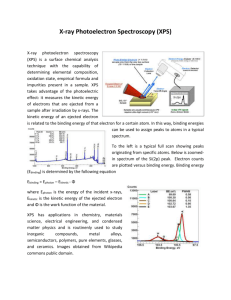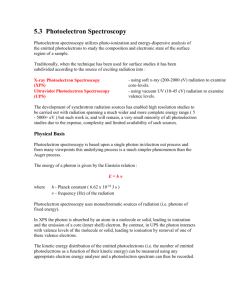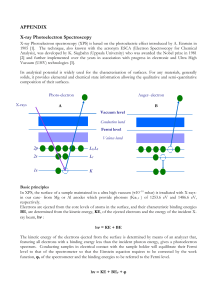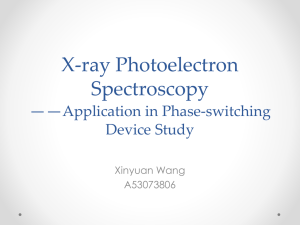XPS
advertisement
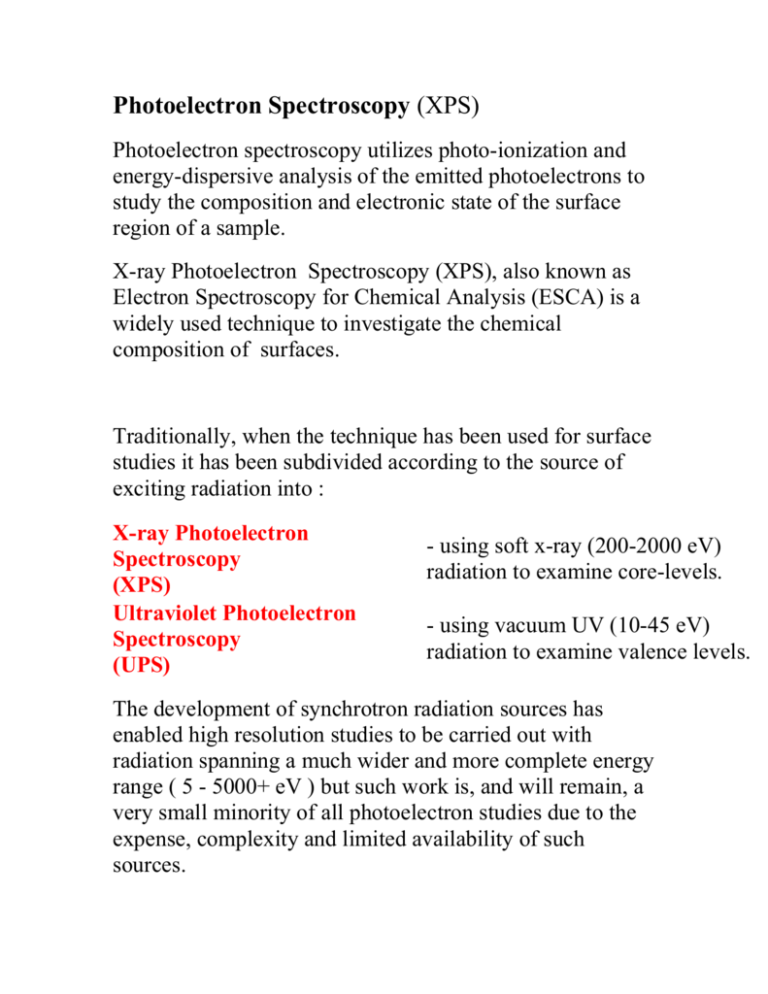
Photoelectron Spectroscopy (XPS)
Photoelectron spectroscopy utilizes photo-ionization and
energy-dispersive analysis of the emitted photoelectrons to
study the composition and electronic state of the surface
region of a sample.
X-ray Photoelectron Spectroscopy (XPS), also known as
Electron Spectroscopy for Chemical Analysis (ESCA) is a
widely used technique to investigate the chemical
composition of surfaces.
Traditionally, when the technique has been used for surface
studies it has been subdivided according to the source of
exciting radiation into :
X-ray Photoelectron
Spectroscopy
(XPS)
Ultraviolet Photoelectron
Spectroscopy
(UPS)
- using soft x-ray (200-2000 eV)
radiation to examine core-levels.
- using vacuum UV (10-45 eV)
radiation to examine valence levels.
The development of synchrotron radiation sources has
enabled high resolution studies to be carried out with
radiation spanning a much wider and more complete energy
range ( 5 - 5000+ eV ) but such work is, and will remain, a
very small minority of all photoelectron studies due to the
expense, complexity and limited availability of such
sources.
Physical Basis
Photoelectron spectroscopy is based upon a single photon
in/electron out process and from many viewpoints this
underlying process is a much simpler phenomenon than the
Auger process.
The energy of a photon is given by the Einstein relation :
E=hν
where h - Planck constant ( 6.62 x 10-34 J s )
ν - frequency (Hz) of the radiation
Photoelectron spectroscopy uses monochromatic sources of
radiation (i.e. photons of fixed energy).
In XPS the photon is absorbed by an atom in a molecule or
solid, leading to ionization and the emission of a core
(inner shell) electron. By contrast, in UPS the photon
interacts with valence levels of the molecule or solid,
leading to ionisation by removal of one of these valence
electrons.
The kinetic energy distribution of the emitted
photoelectrons (i.e. the number of emitted photoelectrons
as a function of their kinetic energy) can be measured using
any appropriate electron energy analyser and a
photoelectron spectrum can thus be recorded.
Ejected Photoelectron
Incident X-ray
Free
Electron
Level
Fermi
Level
Conduction Band
Valence Band
2p
L2,L3
2s
L1
1s
K
Emitted Auger Electron
Conduction Band
Free
Electron
Level
Fermi
L evel
Valence Band
2p
L2,L
2s
L1
1s
K
The process of photoionization can be considered in several
ways : one way is to look at the overall process as follows :
A + h A+ + eConservation of energy then requires that :
E(A) + h = E(A+ ) + E(e-)
Since the electron's energy is present solely as kinetic
energy (KE) this can be rearranged to give the following
expression for the KE of the photoelectron :
KE = h - ( E(A+ ) - E(A) )
The final term in brackets, representing the difference in
energy between the ionized and neutral atoms, is generally
called the binding energy (BE) of the electron - this then
leads to the following commonly quoted equation :
KE = h - BE
An alternative approach is to consider a one-electron model
along the lines of the following pictorial representation ;
this model of the process has the benefit of simplicity but it
can be rather misleading.
The BE is now taken to be a direct measure of the energy
required to just remove the electron concerned from its
initial level to the vacuum level and the KE of the
photoelectron is again given by :
KE = h - BE - Ф
NOTE - the binding energies (BE) of energy levels in
solids are conventionally measured with respect to the
Fermi-level of the solid, rather than the vacuum level. This
involves a small correction to the equation given above in
order to account for the work function () of the solid.
KE = h - BE - Ф
Defining the work function
Sample/Spectrometer Energy Level Diagram- Conducting
Sample
e
-
Sample
V ac uum
Lev el , E v
Fermi Level,
Ef
E
1s
h
v
KE(1
s)
sam
ple
Spectromete
r
KE(1
s)
sp
ec
BE(1
s)
Beca1usse the Fermi levels of the sample and
spectrometer are aligned, we only need to know the
spectrometer work function, spec, to calculate
BE(1s).
Sample/Spectrometer Energy Level DiagramInsulating Sample
e
-
Sample
Free Electron
Energy
V ac uum
Lei vLeel,ve
Elv,
Ferm
Ef
Spectrometer
KE(1
s)
sp
hv
ec
Ec
h
BE(1
s)
1s A relative build-up of electrons at the
spectrometer raises the Fermi level of the
spectrometer relative to the sample. A
potential Ech will develop.
E
Where do Binding Energy Shifts Come From?
-or How Can We Identify Elements and Compounds?
For each and every element, there will be a characteristic
binding energy associated with each core atomic orbital i.e.
each element will give rise to a characteristic set of peaks
in the photoelectron spectrum at kinetic energies
determined by the photon energy and the respective binding
energies.
Pure
Element
Fermi
Level
Electron-electron
repulsion
Electron
Electron-nucleus
attraction
Nucleus
Binding
Energy
Look for changes
here by observing
electron binding
energies
ElectronNucleus
Separation
The presence of peaks at particular energies therefore
indicates the presence of a specific element in the sample
under study - furthermore, the intensity of the peaks is
related to the concentration of the element within the
sampled region. Thus, the technique provides a quantitative
analysis of the surface composition and is sometimes
known by the alternative acronym , ESCA (Electron
Spectroscopy for Chemical Analysis).
The most commonly employed x-ray sources are those
giving rise to :
Mg K radiation : h = 1253.6 eV
Al K radiation : h = 1486.6 eV
The emitted photoelectrons will therefore have kinetic
energies in the range of ca. 0 - 1250 eV or 0 - 1480 eV .
Since such electrons have very short IMFPs in solids (see
Section 5.1) , the technique is necessarily surface sensitive.
Example 1 - the XPS spectrum of Pd metal
The diagram below shows a real XPS spectrum obtained
from a Pd metal sample using Mg K radiation
- the main peaks occur at kinetic energies of ca. 330, 690,
720, 910 and 920 eV.
Since the energy of the radiation is known it is a trivial
matter to transform the spectrum so that it is plotted against
BE as opposed to KE.
The most intense peak is now seen to occur at a binding
energy of ca. 335 eV
Working downwards from the highest energy levels ......
1. the valence band (4d,5s) emission occurs at a binding
energy of ca. 0 - 8 eV ( measured with respect to the
Fermi level, or alternatively at ca. 4 - 12 eV if
measured with respect to the vacuum level ).
2. the emission from the 4p and 4s levels gives rise to
very weak peaks at 54 and 88 eV respectively
3. the most intense peak at ca. 335 eV is due to emission
from the 3d levels of the Pd atoms, whilst the 3p and
3s levels give rise to the peaks at ca. 534/561 eV and
673 eV respectively.
4. the remaining peak is not an XPS peak at all ! - it is an
Auger peak arising from x-ray induced Auger
emission. It occurs at a kinetic energy of ca. 330 eV
These assignments are summarised below ...
It may be further noted that
there are significant differences in the natural widths
of the various photoemission peaks
the peak intensities are not simply related to the
electron occupancy of the orbitals
Exercise 1 - the XPS spectrum of NaCl
The diagram opposite shows an
energy level diagram for sodium
with approximate binding energies
for the core levels.
If we are using Mg K ( h = 1253.6
eV ) radiation ...
... at what kinetic energy will the
Na 1s photoelectron peak be
observed ?
(the 1s peak is that resulting from
photoionisation of the 1s level)
... at what kinetic energy will the
Na 2s and 2p photoelectron peaks be
observed ?
Spin-Orbit Splitting
Closer inspection of the spectrum shows that emission from
some levels (most obviously 3p and 3d ) does not give rise
to a single photoemission peak, but a closely spaced
doublet.
We can see this more clearly if, for example, we expand the
spectrum in the region of the 3d emission ...
The 3d photoemission is in fact split between two peaks,
one at 334.9 eV BE and the other at 340.2 eV BE, with an
intensity ratio of 3:2 . This arises from spin-orbit coupling
effects in the final state. The inner core electronic
configuration of the initial state of the Pd is :
(1s)2 (2s)2 (2p)6 (3s)2 (3p)6 (3d)10 ....
with all sub-shells completely full.
The removal of an electron from the 3d sub-shell by photoionization leads to a (3d)9 configuration for the final state since the d-orbitals ( l = 2) have non-zero orbital angular
momentum, there will be coupling between the unpaired
spin and orbital angular momenta.
Justification: Because and electron has spin angular
momentum, and because moving charges generate
magnetic fields, and electron has a magnetic moment
arising from its spin. Similarly, an electron with orbital
angular momentum (that is an electron with l > 0) is in a
circular current, and posses a magnetic that arises from its
orbital momentum. The interaction of the spin magnetic
moment with the magnetic field arising from the orbital
angular moment is called spin-orbit coupling.
The strength of the coupling and its effect on the energy
levels of the atom, depends on the relative orientations of
the spin and orbital magnetic moments. One way of
expressing this dependence is to say that it depends on the
total angular momentum of the electron, the vector sum of
its spin and orbital momenta. The total angular momentum
is described by the quantum numbers, j and m.
If we consider the final ionised state of Pd within the
Russell-Saunders coupling approximation, the (3d)9
configuration gives rise to two states (ignoring any
coupling with valence levels) which differ slightly in
energy and in their degeneracy ...
2
D 5/2
2
D 3/2
gJ = 2x{5/2}+1 = 6
gJ = 2x{3/2}+1 = 4
These two states arise from the coupling of the l = 2 and s =
1/2 vectors to give permitted J values of 3/2 and 5/2. j = l +
½ or j = l - ½
The lowest energy final state is the one with maximum J
(since the shell is more than half-full), i.e. J = 5/2, hence
this gives rise to the "lower binding energy" peak.
The relative intensities of the two peaks reflects the
degeneracies of the final states (gJ = 2j +1), which in turn
determines the probability of transition to such a state
during photoionization.
The peaks themselves are conventionally annotated as
indicated - note the use of lower case lettering
This spin-orbit splitting is of course not evident with slevels (l = 0), but is seen with p,d & f core-levels which all
show characteristic spin-orbit doublets.
Chemical Shifts
The exact binding energy of an electron depends not only
upon the level from which photoemission is occurring, but
also upon :
1. the formal oxidation state of the atom
2. the local chemical and physical environment
Changes in either (1) or (2) give rise to small shifts in the
peak positions in the spectrum - so-called chemical shifts .
Such shifts are readily observable and interpretable in XP
spectra (unlike in Auger spectra) because the technique :
is of high intrinsic resolution (as core levels are
discrete and generally of a well-defined energy)
is a one electron process (thus simplifying the
interpretation)
Atoms of a higher positive oxidation state exhibit a higher
binding energy due to the extra coulombic interaction
between the photo-emitted electron and the ion core.
This ability to discriminate between different oxidation
states and chemical environments is one of the major
strengths of the XPS technique.
Examples of chemical shifts
High resolution XPS of Ti 2p features. The binding energy
is sensitive to oxidation state. As the atom cores attain
more positive charge the electron levels are pulled close to
the nucleus and the binding energy increases – in this case
metal going to oxide exerts a 4.5 eV shift.
Here an increase in positive charge shifts the C1s signal.
Peaks are separated by deconvolution because resolution is
not perfect.
Chemical shift of C1s features with chemical state
In practice, the ability to resolve between atoms exhibiting
slightly different chemical shifts is limited by the peak
widths which are governed by a combination of factors ;
especially
the intrinsic width of the initial level and the lifetime
of the final state
the line-width of the incident radiation - which for
traditional x-ray sources can only be improved by
using x-ray monochromators
the resolving power of the electron-energy analyser
In most cases, the second factor is the major contribution to
the overall line width.
Angle Dependent Studies
The degree of surface sensitivity of an electron-based
technique such as XPS may be varied by collecting
photoelectrons emitted at different emission angles to the
surface plane. This approach may be used to perform nondestructive analysis of the variation of surface composition
with
Information depth = dsin
d = Escape depth ~ 3
= Emission angle
relative to surface
=Inelastic Mean Free
Path
=15°
More Surface
Sensitive
= 90°
Less Surface
Sensitive
Example 1 : Angle-Dependent Analysis of a Silicon Wafer with a Native Oxide
Surface Layer
A series of Si 2p photoelectron spectra recorded for
emission angles of 10-90º to the surface plane. Note how
the Si 2p peak of the oxide (BE ~ 103 eV) increases
markedly in intensity at grazing emission angles whilst the
peak from the underlying elemental silicon (BE ~ 99 eV)
dominates the spectrum at near-normal emission angles.
Quantitative Analysis by XPS
For a Homogeneous sample:
I = NσDJLλAT
where: N = atoms/cm3
σ = photoelectric cross-section, cm2
D = detector efficiency
J = X-ray flux, photon/cm2-sec
L = orbital symmetry factor
λ = inelastic electron mean-free path, cm
A = analysis area, cm2
T = analyzer transmission efficiency
N = I/σDJLλAT,
Let denominator = elemental sensitivity factor, S
Can describe Relative Concentration of observed elements
as a number fraction by:
Cx = Nx / ΣNi
Cx = Ix/Sx / ΣIi/Si
The values of S are based on empirical data.
12
3d
Relative Sensitivity
10
8
4f
6
2p
4
4d
1s
2
0
Li B N F Na Al P Cl K Sc V M Co Cu G As Br Rb Y Nb Tc Rh Ag In Sb I Cs La Pr P Eu Tb Ho T Lu Ta Re Ir Au Tl Bi
Be C O Ne M Si S Ar Ca Ti Cr Fe Ni Zn G Se Kr Sr Zr M Ru Pd Cd Sn Te Xe Ba Ce Nd S G Dy Er Yb Hf W Os Pt Hg Pb
Elemental Symbol
XPS of Cu/Ni alloy
120
Peak
Area
Cu 2p
100
Thousands
N(E)/E
Atomic
Conc
4.044
5.321
49
51
Mct-eV/sec
Ni
Cu
80
60
Rel.
Sens.
2.65
3.65
%
Cu
LMM Cu
Ni
LMM Cu
LMM Ni
LMM
LMM Ni
LMM
Ni 2p
40
Ni 3p
20
Cu 3p
0
-1100
-900
-700
-500
Binding Energy (eV)
-300
-100
Instrumentation for XPS
The basic requirements for a photoemission experiment
(XPS or UPS) are:
1. a source of fixed-energy radiation (an x-ray source for
XPS or, typically, a He discharge lamp for UPS)
2. an electron energy analyser (which can disperse the
emitted electrons according to their kinetic energy,
and thereby measure the flux of emitted electrons of a
particular energy)
3. a high vacuum environment (to enable the emitted
photoelectrons to be analysed without interference
from gas phase collisions)
Such a system is illustrated schematically below:
There are many different designs of electron energy
analyser but the preferred option for photoemission
experiments is a concentric hemispherical analyser (CHA)
which uses an electric field between two hemispherical
surfaces to disperse the electrons according to their kinetic
energy.
Schematic – electrons within a range of U of energy E
(retarding voltage on grid) are allowed to pass through the
concentric hemispheres to electron multiplier tubes.
Surface analysis by XPS requires irradiating a solid in an
Ultra-high Vacuum (UHV) chamber with monoenergetic
soft X-rays and analyzing the energies of the emitted
electrons.
Degree of Vacuum
Pressure
Torr
102
Low Vacuum
10- 1
Medium Vacuum
High Vacuum
10- 4
10- 8
Ultra-High Vacuum
10-11
Remove adsorbed gases
from the sample.
Eliminate adsorption of
contaminants on the
sample.
Prevent arcing and high
voltage breakdown.
Increase the mean free path
for electrons, ions and
photons.
Ultraviolet Photoelectron Spectroscopy (UPS)
In UPS the source of radiation is normally a noble gas
discharge lamp ; frequently a He-discharge lamp emitting
He I radiation of energy 21.2 eV .
Such radiation is only capable of ionising electrons from
the outermost levels of atoms - the valence levels. The
advantage of using such UV radiation over x-rays is the
very narrow line width of the radiation and the high flux of
photons available from simple discharge sources. The main
emphasis of work using UPS has been in studying :
1. the electronic structure of solids - detailed angle
resolved studies permit the complete band structure to
be mapped out in k-space.
2. the adsorption of relatively simple molecules on
metals - by comparison of the molecular orbitals of the
adsorbed species with those of both the isolated
molecule and with calculations.
